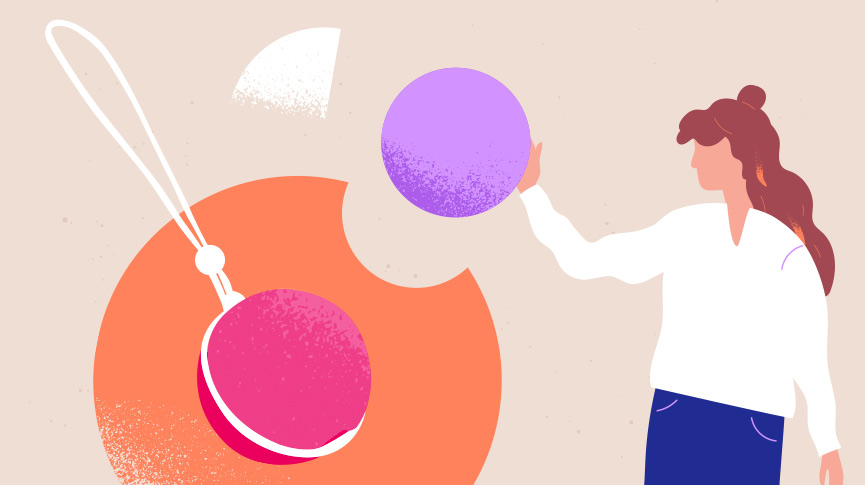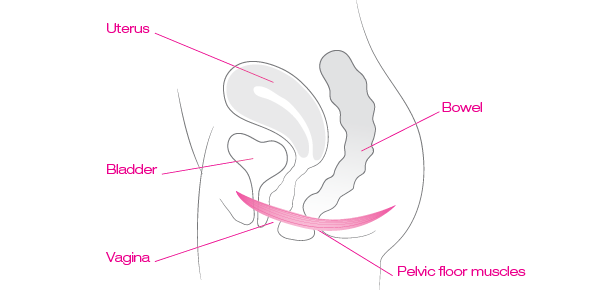14 Things You Didn’t Know About Your Pelvic Floor Muscles

This article was medically fact-checked by Women’s health expert and Gynaecologist Dr. Alyssa Dweck.
When it comes to being fit and healthy, it’s not just what’s on the outside that counts. No siree, staying in shape is as much about the inside as the out. And yet, a hugely important part of our internal anatomy is constantly overlooked when we discuss exercise or anything else for that matter… The muscles of the pelvic floor have perhaps the lengthiest job description of any in the body; supporting many of our internal organs, controlling the bladder and bowel, and key in determining the frequency and magnitude of our orgasms. Put it this way, we owe them big time!
Understanding what these muscles do and how we can make them do it better has HUGE rewards. So, let’s get acquainted with everything pelvic floor!
1. The Best Hammock Ever
Imagine a big ol’ hammock in your lower pelvis bearing the weight of your bladder, bowel, and uterus – well this is exactly what your pelvic floor does. Stretching from the tailbone to the pubic bone (front to back) and side to side, these muscles can be strong, weak, long or short, tight or loose and they contract and relax depending on what we’re doing.

The position of the pelvic floor muscles in the body
2. They LOVE Your Urethra, Vagina, And Anus…
They hug them pretty much ALL the time, seriously. Looping tightly around our urethral and anal sphincters, our pelvic floor muscles are vital in helping us maintain continence (they prevent us from peeing or pooing ourselves). Also embracing our vagina (who wouldn’t?), these wondrous muscles are responsible for our big ‘O’s – but more about that later…

Layers of pelvic floor including sphincters
3. You Know Them Better Than You Think You Do.
You may still be like, “Huh? Pelvic floor muscles? I know not of what you speak”. While we may not be able to see these muscles, you use them all the time. The most recognizable example is suddenly stopping your flow of pee midstream – ever had to answer the phone while on the toilet or had someone walk in on you suddenly? Well, that’s you contracting your pelvic floor muscles.
4. You Can Feel Them Working Though.
If you want to go a step further and actually feel the muscles at work, you can place a clean finger inside your vagina and squeeze (lifting your pelvic floor up) just like you’re stopping urine flow (see above – sans pee please). Generally the muscles work unconsciously but as these conscious contractions prove, you can train your pelvic floor to be stronger, healthier and more reactive.
5. Now For The Really Good Bit.
The stronger your pelvic floor, the bigger, bolder and more brazen your orgasms! The contractions we experience during climax come, in large part, from the pelvic floor so the healthier and more taut they are, the more powerful and intense these spasms will be. Where do we sign up?
6. Heave Ho!
During pregnancy, the pelvic floor muscles are hugely important for supporting the uterus and cervix which support the baby and they are vital during childbirth. Those contractions all moms love so much? Yeah, that’s your uterus and pelvic floor at work. When your midwife says, ‘PUSH!’ it’s your pelvic floor that heeds their hollerin’ (with a little help from the uterus), so if you have healthier muscles, delivery is going to be way easier.
7. Speaking Of Babies.
When pushing a baby out of the vagina – again, well done moms – the pelvic floor muscles, cervix, and vaginal tissue stretch incredible to allow the baby to pass through. Afterwards, many women experience postpartum pain from such hard work and even occasional incontinence due to weakened muscles – however strengthening them through exercise can help women recover a lot faster.
8. Essential Estrogen.
Estrogen is one of the most important hormones in the female body, responsible for the health of everything from our hair, skin, eyes and yes – you guessed it, our pelvic floor too! During menopause when estrogen levels plummet, the pelvic floor can weaken and lead to struggles with light bladder leakage, organ relaxation or prolapse, and pain. For more info on vaginal changes in menopause, click here.
9. They’re The Strong, Silent Type…
Having a strong core isn’t all about abs. The pelvic floor is, quite literally, the foundation of the rest of our upper body and if it’s strong, healthy and doing its job properly, the whole body wins.
10. You Can Pump Them Up!
You can strengthen these all important muscles by doing pelvic floor exercises called Kegels. Kegels were first described by Dr. Arnold Kegel in 1948 and have since been recommended by gynecologists all over the world as an easy, noninvasive and effective way to improve pelvic floor health.
11. And LIFT
To do a Kegel, contract your pelvic floor (lift upwards), hold the contraction for a few seconds, then relax and repeat. Remember to squeeze and lift, not push, or you might end up doing more damage than good. Over time you can adjust the rhythm and length of time you hold each contraction to enhance your routine and its results.
12. Sounds Easy Right?
Actually, research shows that around 50% of women are unable to do a Kegel contraction correctly. You can check out our Beginner’s Guide to Kegels and our list of the most common Kegel mistakes for excellent tips on nailing it!
13. There’s More To Them Than You Think…
The pelvic floor is a pretty complex system which includes both fast-twitch and slow twitch muscle fibers. Fast-twitch muscles are those that react rapidly to stimuli; think a quick sprint. Slow-twitch muscle fibers are in for the long haul, like an endurance run. Kegel exercises likely rely on both depending on the rhythm, duration, strength, and frequency achieved. Think high intensity interval training (HIIT) for your vagina!
14. Up Your Game!
While doing Kegels solo is great for improving pelvic floor strength, throwing some exercising aids into the mix can up your game in a big way. Weighted exercisers are like weights at the gym, providing resistance so that your pelvic floor has to work that bit harder to perform each contraction. Smart Kegel exercisers, on the other hand, are like personal trainers, doing all the thinking for you. Using touch sensors, exercisers like KegelSmart register your pelvic floor strength and create a personalized routine for you. When the device vibrates, you contract and when it pauses, you relax. Pretty neat right? These devices guide you through progressive levels so you get the most out of every squeeze.
The final fact you may be unaware of? Your pelvic floor is AWESOME! These modest muscles don’t get enough credit for all the hard work they do and the integral role they play in the health of our bodies. Taking care of your pelvic floor and making sure it’s in tip-top shape can improve your life in immeasurable ways, so what are you waiting for? Get squeezin’!
Facts checked by:
Dr. Alyssa Dweck
Alyssa Dweck MS, MD, FACOG is a practicing gynecologist in Westchester County, New York. She provides care to women of all ages; she has delivered thousands of babies. She is proficient in minimally invasive surgery and has special interest and expertise in female sexual health and medical sex therapy. She is top doctor in New York Magazine and Westchester Magazine. Dr. Dweck has co-authored three books including the most recent release The Complete A to Z For Your V.
Written by:

A collective group of “lady experts” at Intimina who love sharing our personal experiences, even when they are a little too personal. We believe it’s time to start breaking down the taboos around menstruation, motherhood, and menopause, and start owning our female health.





Sounds great. Will give it a try.
Great article, ?